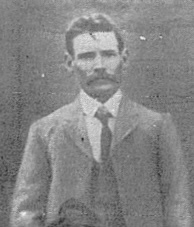MEHARRY, Robert John
| Service Number: | 4865 |
|---|---|
| Enlisted: | Not yet discovered |
| Last Rank: | Private |
| Last Unit: | 31st Infantry Battalion |
| Born: | Not yet discovered |
| Home Town: | Not yet discovered |
| Schooling: | Not yet discovered |
| Occupation: | Not yet discovered |
| Memorials: |
World War 1 Service
| 7 Feb 1917: | Involvement Private, 4865, 31st Infantry Battalion, --- :embarkation_roll: roll_number: '16' embarkation_place: Sydney embarkation_ship: HMAT Wiltshire embarkation_ship_number: A18 public_note: '' | |
|---|---|---|
| 7 Feb 1917: | Embarked Private, 4865, 31st Infantry Battalion, HMAT Wiltshire, Sydney |
Robert's life story
Robert John “Bob” Meharry was born in Kerang to William Meharry and Sarah Fellows on April 16, 1876, the eldest of his seven brothers. His father had come to Australia in 1871 with his brother, Thomas, in search of gold in Bendigo, though he soon married and settled in Mologa on a plot of land adjacent to his brother. While he lived in Kerang, Robert learnt a trade as a builder from his uncle, George William Adams, whose father was a carpenter and a pioneer. Robert lived in Kerang until 1896, when he, his uncle Thomas and his father moved to Marracoonda, Western Australia. There, Robert took up a job as a builder with his father, who had also learnt the trade, and together they built their family home. During this time, he accidentally had his index finger on his right hand cut off.
In 1902, his mother and the rest of his family came to Marracoonda, and they named the house ‘Gannawarra’. This house still stands to this day, now occupied by the Beeck family. Robert would then build his own house on his own property in the following two years.
On April 6, 1904, Robert married Ada Mary Smith, who he met in Perth, and they moved back to Marracoonda together. It was at this time that Robert’s father lost all his money due to the bank collapse, and Robert allowed his father to build a small house on his property, where the rest of his family lived until 1906, when Robert and Ada moved to Canada for four years. There, they had two children, Alberta and Evelyn. They returned to Australia in 1910, and settled in Brisbane where they had two more children Ronald and Dorothy. On December 28, 1916, Robert enlisted for the Great War, and was assigned to the 31st Infantry Battalion. Due to him missing his index finger, which would have typically been needed for shooting, he was sent to England, where he served in both the No. 2 Command Depot in Weymouth and the No. 4 Command Depot in Codford, which were installed to receive and process men from hospitals and convalescent camps who were deemed fit enough to return to service within three months. They were responsible for rehabilitating and retraining men in an attempt to keep as many men from being sent home, in response to the decreasing number of men enlisting due to high casualty rates. On January 31, 1918, over a month after the end of the Great War, Robert was discharged and sent en route to Australia on board HMAT A8 Argyllshire, which stopped at Cape Town, South Africa on March 1. Robert was due to board RMS Osterley on March 30, but for unknown reasons, he missed the deadline and was absent for its departure from the port. Three days later, Robert stowed away on the Llanstephan Castle, a British ship which was also due for a journey to Australia. Robert remained undetected on the ship for 20 days, but was eventually discovered on April 12, and his presence reported by cablegram. Despite this, he never received any disciplinary action.
Robert lived the remainder of his life with his own family in Queensland. He was mentioned in the Toowoomba Chronicle in August 1919 after he and his friend W. Duke discovered a large silver and lead deposit on land situated in Brisbain. In Robert would pass away at the age of 72 on March 24, 1949, with his wife Ada passing away on August 18, 1982 at the age of 97.
Submitted 16 December 2024 by Hayden Beasy










